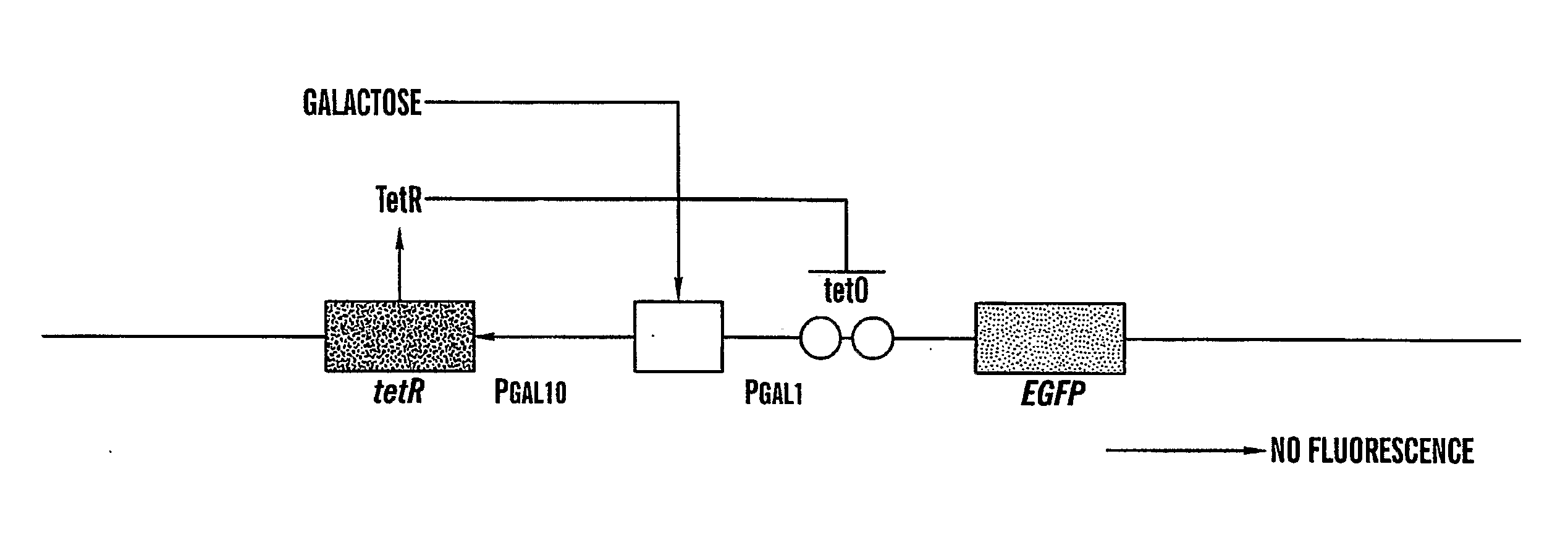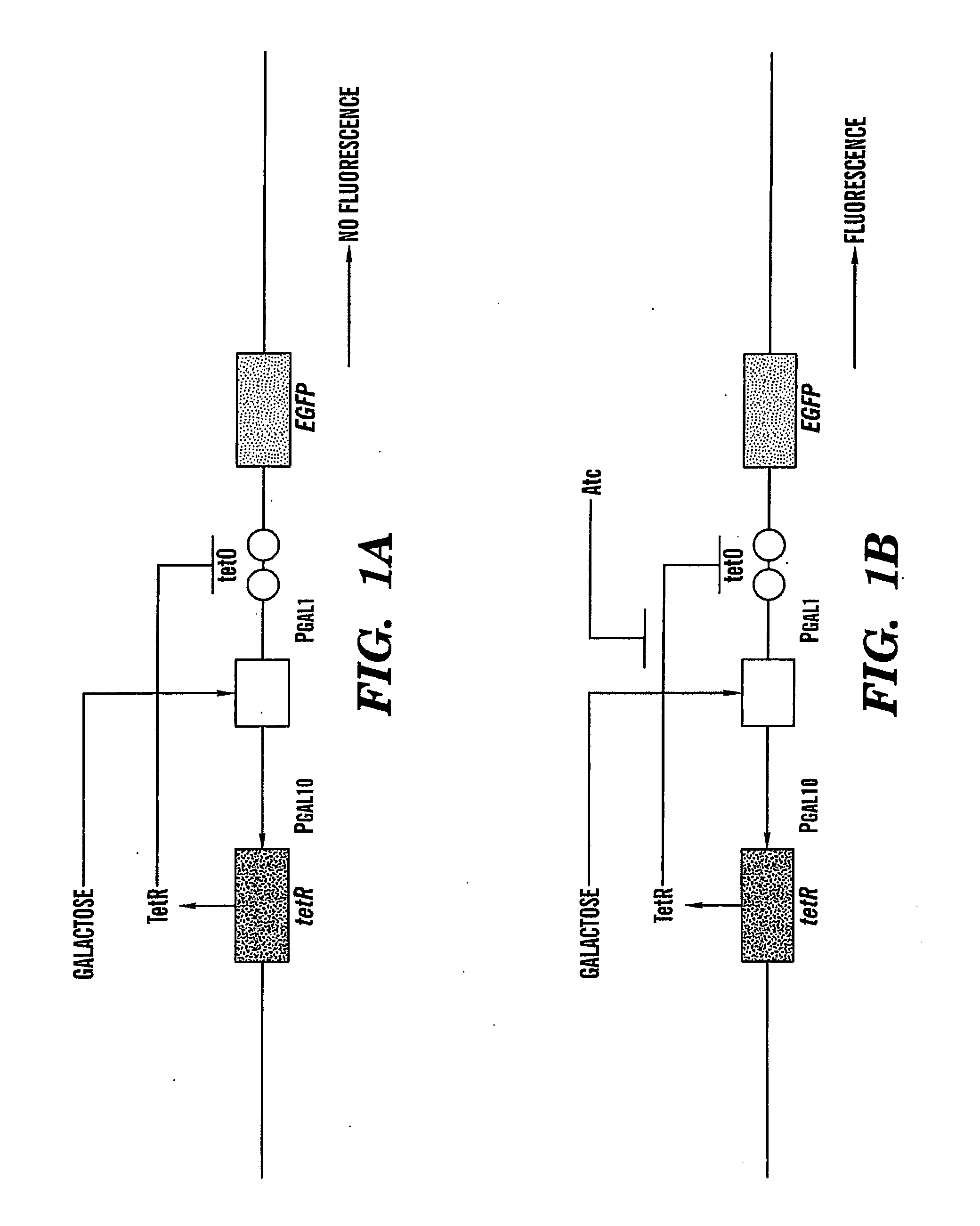Real time nucleic acid detection in vivo using protein complementation
- Summary
- Abstract
- Description
- Claims
- Application Information
AI Technical Summary
Benefits of technology
Problems solved by technology
Method used
Image
Examples
example 1
Methods of Protein-Complementation Facilitated by Nucleic Acid Interactions
[0180]To show the workability of fast protein complementation facilitated by nucleic acid interactions, several experiments were performed in vitro. FIGS. 20a, 20b show how nucleic acid interaction discussed herein work. In these experiments, enhanced Green Fluorescent protein (EGFP) was chosen as a marker-protein for several numerous reasons. First, activity of EGFP is easily determined by the presence of characteristic fluorescence. Second, fluorescent proteins from the GFP family have already been successfully used as markers or detector proteins in several protein-protein complementation studies for example, Ozawa et al., 2000, Ozawa et al., 2001a,b; Ghosh et al., 2000; Hu et al., 2002; Hu & Kerppola, 2003; Remy & Michnick, 2004; Magliery et al., 2005 which demonstrate schemes to successfully split EGFP.
[0181]These studies showed that the loop between 153-161 amino acids in EGFP is a convenient site for s...
example 2
Detection Proteins for Directed Fast Protein Complementation
[0184]In example 1, the marker-protein or detector protein in the protein complementation is a fluorescent protein, namely, the enhanced green fluorescent protein (EGFP), which is a double mutant of the jellyfish Aequorea victoria GFP (F64L, S65T). Splitting of EGFP and other related fluorescent proteins at residues 154-158 has been successfully used in several studies designed to test protein / protein interactions in vivo (Ghosh et al., 2000; Hu & Kerppola, 2003; Remy & Michnick 2004; Magliery et al., 2005). These studies showed that the re-assembly of active EGFP from its fragments in vivo does not happen spontaneously but requires an additional protein / protein interaction (Maglieri et al., 2005). Additionally, it has been shown that EGFP re-assembly is quite tolerant to the size of interacting proteins: (Ghosh et al., 2000; Hu & Kerppola, 2003; Remy & Michnick 2004; Magliery et al., 2005).
[0185]To use protein complementat...
example 3
Conjugation of Detector Protein and Nucleic Acid Binding Protein
[0197]In this experiment we verified that expression of the two dissected protein chimeras will not result in reconstituted fluorescence in the absence of the interacting aptamer sequence. This experiment was performed in E. coli. Fragments of EGFP gene were obtained by PCR from the plasmid pEGFP (Clontech). Splitting of EGFP gene was in the same position as in experiments in vitro (1-158, 159-239). The plasmid containing full-size eIF4A (pGEX-4A1) was utilized. The F1 and F2 fragments of eIF4A were obtained by PCR, splitting was performed according to Oguro et al. (see FIG. 3). Two fusion proteins with an SG linker were inserted into two plasmids pETDuet 1 and pACYDuet-1 (Novagen) constructed for co-expression of two messages. These two plasmids have different origins of replication and different selective markers. The resulting plasmids pMB12 and pMB13 were co-expressed in E. coli strain BL21 (DE3) (Novagen). In pMB12...
PUM
| Property | Measurement | Unit |
|---|---|---|
| Volume | aaaaa | aaaaa |
| Volume | aaaaa | aaaaa |
| Volume | aaaaa | aaaaa |
Abstract
Description
Claims
Application Information
 Login to View More
Login to View More - R&D
- Intellectual Property
- Life Sciences
- Materials
- Tech Scout
- Unparalleled Data Quality
- Higher Quality Content
- 60% Fewer Hallucinations
Browse by: Latest US Patents, China's latest patents, Technical Efficacy Thesaurus, Application Domain, Technology Topic, Popular Technical Reports.
© 2025 PatSnap. All rights reserved.Legal|Privacy policy|Modern Slavery Act Transparency Statement|Sitemap|About US| Contact US: help@patsnap.com



